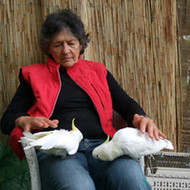Introducing me and my birds - Dorothy Schwarz
Posted by Dorothy Schwarz on 30th Jul 2014
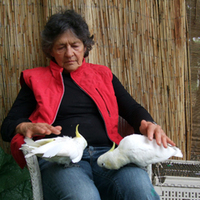
I’m Dot Schwarz and in the coming months I’ll be sharing with you some of the joys and heartaches, pleasant surprises and shocks of a parrot person’s life. I’ll tell about the lives of my birds and those of others that I know. I’d like to share some of the theoretical knowledge and insights that I’ve developed from my avian involvement. I trained at workshops and seminars with Steve Martin in Florida, Susan Friedman in France and Ireland and Barbara Heidenreich in USA and UK. These trainers all practice and teach positive reinforcement training and I’ll be talking about that quite a lot.
I am often asked how my parrot life began. Am I an ex zoo curator, like my friend Bill Naylor, am I an ornithologist, a zoologist or a professional trainer? No, I’m none of those. However, for the last fifteen years, parrots, people involved with them, learning about parrots, keeping parrots – even breeding them in a small way - has become my main preoccupation.
It began by chance as I believe many of our passions do. Most of my adult life has been involved in some sort of breeding: six kids, horses as a small business, dogs, cats, rabbits and now birds. I had been riding, training and breeding horses in a small way. With middle age and the children leaving the nest, horses began to play a lesser role in our lives. And then one of my horsy friends, Barett Watson, who is one of the foremost UK trainers of show jumpers, opened up a new world for me. I’d known Barrett and his partner Tim Davies for years. Their yard is a visual delight of immaculate horses - and flocks of macaws, cockatoos, and greys in large flights with individual cages for breeding pairs. A pet bird that comes from Barrett is already accustomed to people and socialized.
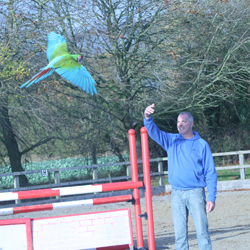
Keen for a new challenge, I asked Barrett for one of his baby birds. We discussed the situation and decided that African Greys would be the best choice for a somewhat older couple.
Barrett had a bonded pair. In early December, he phoned ‘the hen is sitting.’ Two weeks after hatching, the chicks were pulled for hand rearing and Barrett suggested I visit as often as possible to learn how to handle the birds. What a valuable education Barrett gave me! You learn so much more from hands-on practice than from books. The chicks looked unappealing, featherless and squirming, like blackbirds that had fallen out of the nest. ‘Aren’t they adorable?’ said Tim. He proceeded to hand feed them with skill and gentleness. He or Barrett had been doing this at 4- hourly intervals day and night and still found them adorable!
After a few weeks they were nicely feathering up and sharing the incubator and then the weaning cage with a Moluccan cockatoo. One of the chicks seemed bolder than the other. I chose that one.
On my fortnightly visits, I started to hold MY chick and observe what was going on in the nursery. A clutch of military macaws was learning to fly, doing Charlie Chaplin imitations as soon as they landed; some eggs were in incubators. I learnt to handle Barrett’s two enormous Blue and Gold pet macaws. I learnt the difference between birds being reared as pets and ones for breeding. Everything Barrett and Tim did was explained; they were limitlessly patient.
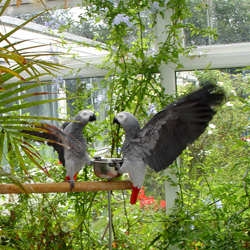
The chicks were also taught to ‘Step up’ before they were even fledged. They were accustomed to household noises like vacuum cleaners and washing machines. On the last visit but one before we bought our bird home, Tim emerged from the nursery with the 2 Greys and the Moluccan perched on his stretched out arm, all four looking pleased as Punch. Another advantage of buying a bird from a reputable breeder is that Artha was harness trained as she was being weaned.
When the chicks pecked, Tim would gently blow the top of their heads and say, ‘Don’t bite.’ This technique worked with our bird once we got it home. Hand on heart I can say that Artha has never bitten a human in 15 years. (To be 100% honest, I have to say she has bitten other birds.) Her name is Artha because she was at first thought to be a cock bird whom we named Arthur. After a month at home, I decided that Arthur perched like a hen bird. A DNA test proved me right. Being so used to calling Arthur we feminised the name to Artha. That happened fifteen years ago.
A home made aviary was constructed to give the birds fresh air and space to fly. And the aviary itself – like Topsy ‘it just growed’. We added sections yearly until the whole aviary now measures 40 metres in length. The trees inside have grown and I am terribly proud when I cannot see the inhabitants who are amongst the leaves.
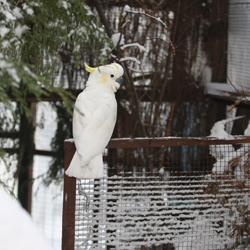
Our family suffered a personal tragedy when our youngest daughter, Zoe, died at 27. Artha’s apparent empathy while I was grieving gave me the urge to devote time and effort to understand birds and providing a home for those in need. Because the aviary is large, I have been offered birds in need of a home.
A year later Casper came from Barrett to keep Artha company. Sad to say they - although good friends - have never mated and produced the patter of tiny claws for us to marvel at.
With birds I entered a new world; birds are not mammals. A puppy, a kitten and a baby share far more traits in common than we do with our pet birds. But one of the most fascinating aspects of parrot keeping is that the modern way of training them by positive reinforcement is also the best way to train your puppy, your kitten - or your partner! I hope to describe positive reinforcement training and give case studies which illustrate how it works out in practice. Theories are great but if they don’t produce the result you want you are apt to discard them.
Need for training

Training is essential for full-winged birds, especially if any of them share your living space. They must know and accept the recall. I’ve had my birds fly out of the house through a carelessly left open window or door but once found, they’ve flown down to me because they know the recall. Casper, an escape artist of almost undescribable genius, has scarpered to the village a quarter of a mile away even before his absence has been noticed. Unfortunately, he likes people and has flown into village houses and into open cars. I’ve been lucky; his newly found human friends were all honest folk and he was returned. But I dare not allow him the liberty he so clearly craves.

